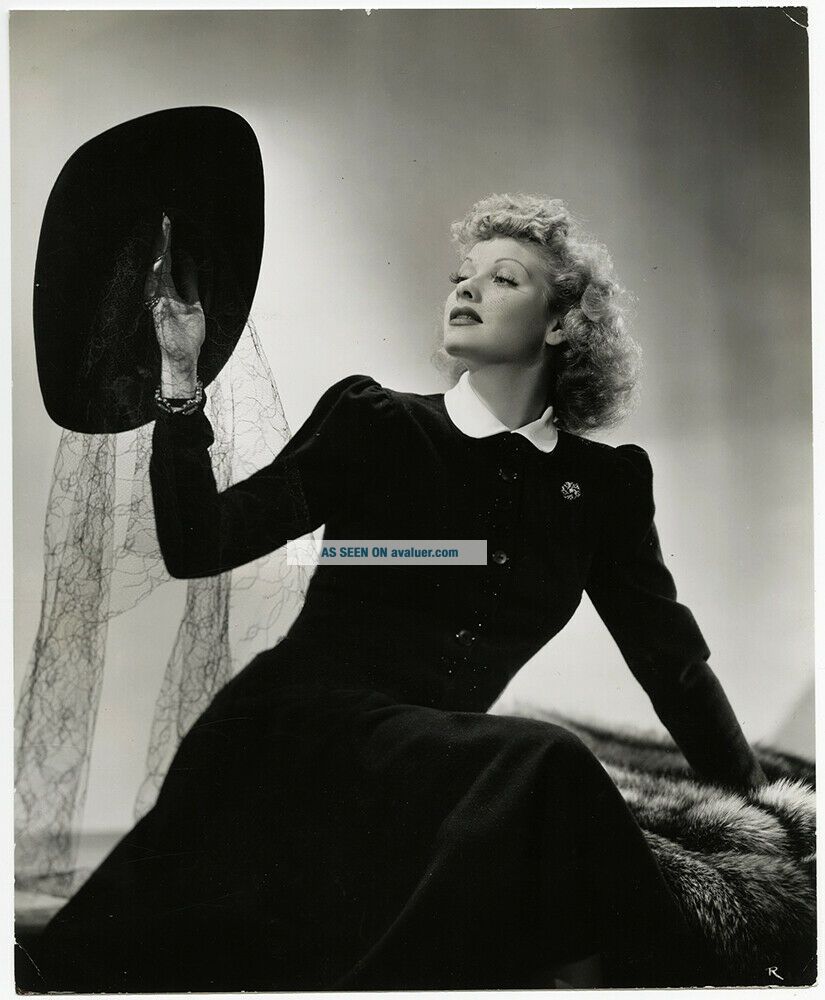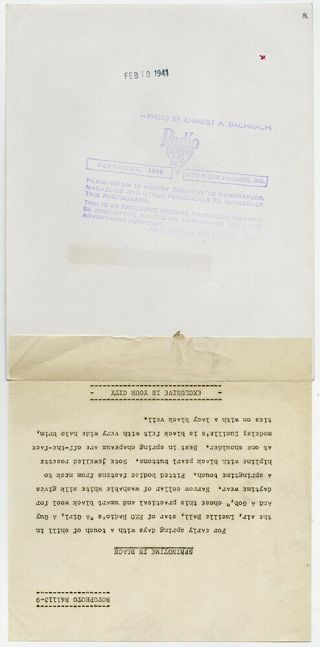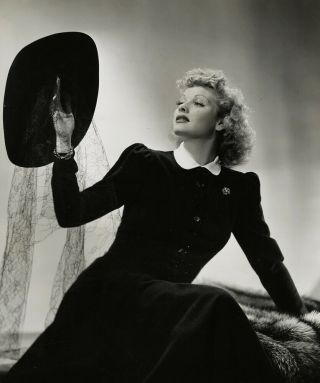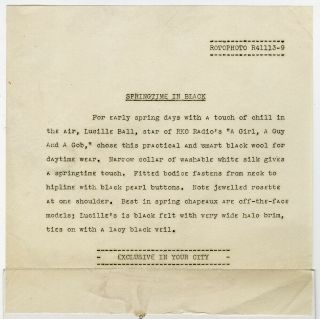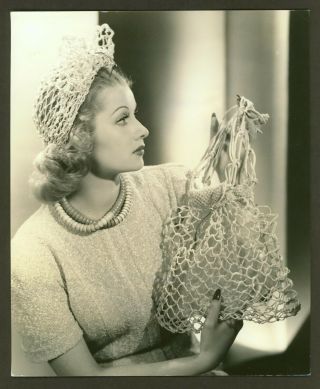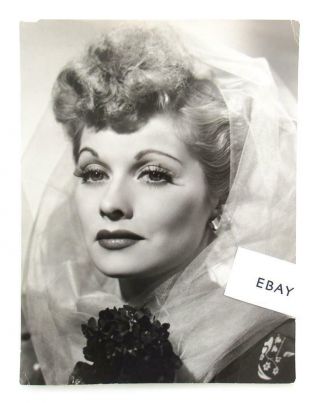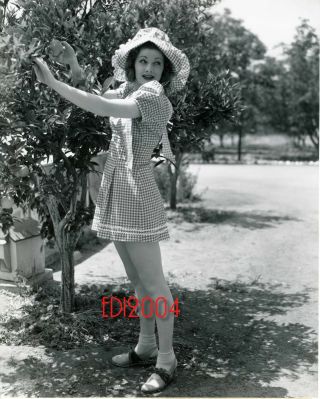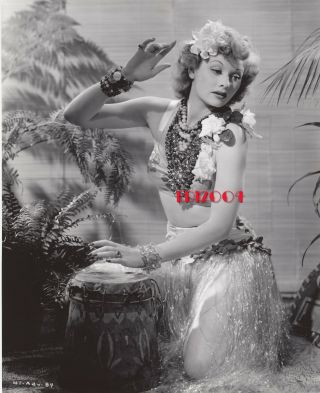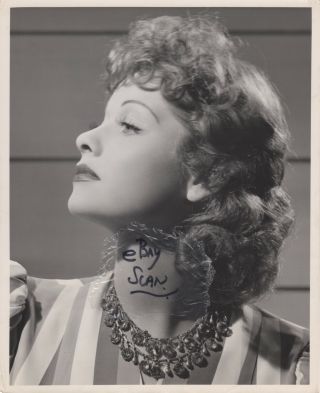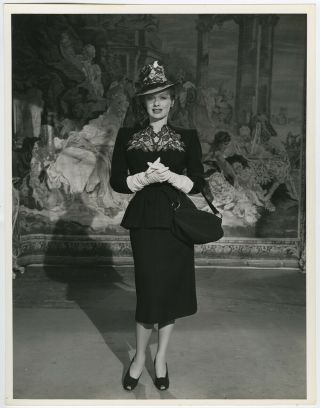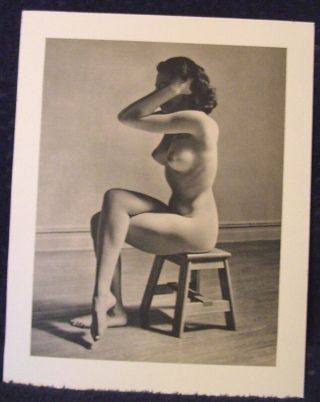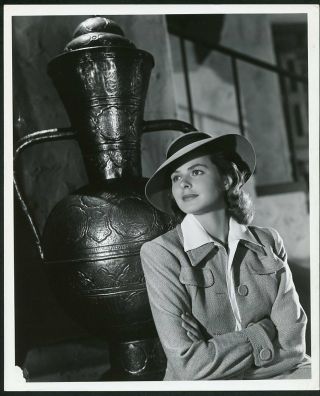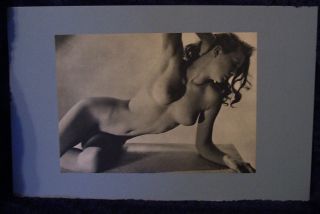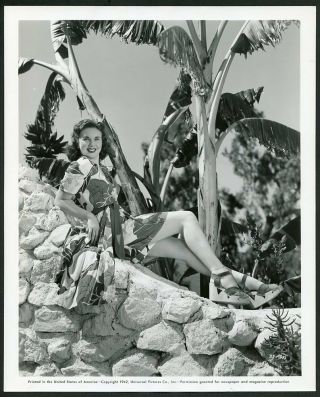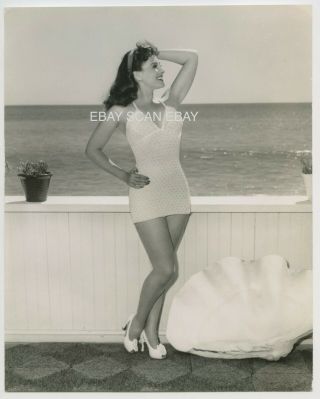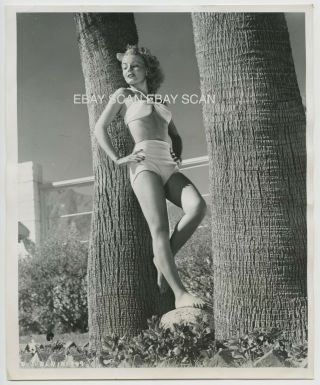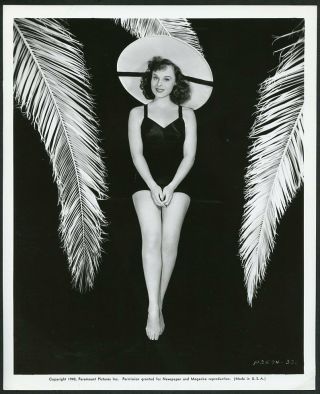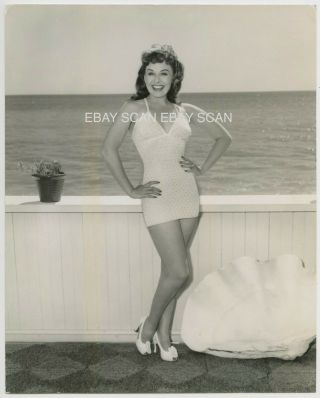Lucille Ball Vintage 1941 Ernest Bachrach Hollywood Fashions Glamour Photograph
Item History & Price
Thanks to all our eBay bidders! We are honored to be your one-stop, 5-star source for vintage pin up, pulp magazines, original illustration art, decorative collectibles and ephemera with a wide and always changing assortment of antique and vintage items from the Victorian, Art Nouveau, Art Deco, and Mid-Century Modern eras. All items are 100% guaranteed to be original, vintage, and as described. Please feel free to contact us with any and all questions about the items and our p...olicies and please take a moment to peruse our other great eBay listings. All sell no reserve!
ITEM: This is a vintage and original RKO Radio Pictures Hollywood fashion photograph. Taken by Ernest A. Bachrach, the photographer has captured a very stylish spring look on actress Lucille Ball. This chic Hollywood Regency portrait wasn't used solely to promote the latest fashions, it also was used in the advertising campaign for Ball's film, the 1941 comedy A Girl, a Guy and a Gob.
The press snipe reads: "SPRINGTIME IN BLACK ... For early spring days with a touch of chill in the air, Lucille Ball, star of RKO Radio's 'A Girl, A Guy And A Gob, ' chose this practical and smart black wool for daytime wear. Narrow collar of washable white silk gives a springtime touch. Fitted bodice fastens from neck to hipline with black pearl buttons. Note jewelled rosette at one shoulder. Best in spring chapeaux are off-the-face models; Lucille's is black felt with very wide halo brim, ties on with a lacy black veil."
Measures 7.5" x 9.25" without margins on a glossy single weight paper stock.
RKO Radio Pictures ink stamp and paper caption on verso.
CONDITION: Fine condition with possibly trimmed edges, corner wear, and light, general storage/handling wear. Please use the included images as a conditional guide.
Guaranteed to be 100% vintage and original from Grapefruit Moon Gallery.
••••••••••••••••••••
The woman who will always be remembered as the crazy, accident-prone, lovable Lucy Ricardo was born Lucille Desiree Ball on August 6, 1911 in Jamestown, New York. Her father died before she was four, and her mother worked several jobs, so she and her younger brother were raised by their grandparents. Always willing to take responsibility for her brother and young cousins, she was a restless teenager who yearned to "make some noise". She entered a dramatic school in New York City, but while her classmate Bette Davis received all the raves, she was sent home; "too shy". She found some work modeling for Hattie Carnegie's and, in 1933, she was chosen to be a "Goldwyn Girl" and appear in the film Roman Scandals (1933).
She was put under contract to RKO Radio Pictures and several small roles, including one in Top Hat (1935), followed. Eventually, she received starring roles in B-pictures and, occasionally, a good role in an A-picture, like in Stage Door (1937) or The Big Street (1942). While filming Too Many Girls (1940), she met and fell madly in love with a young Cuban actor-musician named Desi Arnaz. Despite different personalities, lifestyles, religions and ages (he was six years younger), he fell hard, too, and after a passionate romance, they eloped and were married in November 1940. Lucy soon switched to Metro-Goldwyn-Mayer, where she got better roles in films such as Du Barry Was a Lady (1943); Best Foot Forward (1943) and the Katharine Hepburn-Spencer Tracy vehicle Without Love (1945). In 1948, she took a starring role in the radio comedy "My Favorite Husband", in which she played the scatterbrained wife of a Midwestern banker. In 1950, CBS came knocking with the offer of turning it into a television series. After convincing the network brass to let Desi play her husband and to sign over the rights to and creative control over the series to them, work began on the most popular and universally beloved sitcom of all time.
With I Love Lucy (1951), she and Desi promoted the 3-camera technique now the standard in filming sitcoms using 35mm film (the earliest known example of the 3-camera technique is the first Russian feature film, "Defence of Sevastopol" in 1911). Desi syndicated I Love Lucy.
Lucille Desiree Ball was the first woman to own her own studio as the head of Desilu Productions.
Lucille Ball died at Cedars-Sinai Medical Center, age 77, of an acute aortic aneurysm on April 26, 1989 in Los Angeles, CA.
- IMDb Mini Biography By: Tommy Peter
••••••••••••••••••••
Ernest A. Bachrach, By: Mary Mallory
Hollywood’s motion picture still photography defined sophisticated style, shaped personas and created the iconic image of “a movie star” as we know it today. The photographers’ dramatic lighting, dynamic compositions, artful negative retouching and artistic eyes influenced the American public’s perceptions of celebrities and their personalities. Stars were defined as sexy, glamorous, thoughtful, foreboding, all through the scintillating camerawork of these often unsung and forgotten men.
While photographers such as George Hurrell, Ruth Harriet Louise, Clarence Sinclair Bull, Lazslo Willinger and Eugene Robert Richee came to be recognized for their style as well as their artistic sensibilities, RKO’s chief photographer, Ernest Bachrach, gained fame for taking quality portraits that fitted whatever style was requested by art directors or studio publicity chiefs. His discerning eye easily captured the personal essence of the stars he shot, the most important element of a first-rate photographic image. As John Kobal quotes him in his book, “The Art of the Great Hollywood Portrait Photographers, ” “Portraiture is very closely akin to cinematography. The cinematographer has very little need for accessories in the making of close-ups; all he needs is a face and some lights and shadows. And that is all the portrait artist needs. Occasionally — but only occasionally — minor props are useful.”
Ernest Bachrach was born Oct. 20, 1899, in New York, and his early years are mostly unknown, though he did sign up for duty in World War I, starting his service at New York’s Ft. Slocum.
By the early 1920s, he was a stillsman for Famous Players-Lasky at their Astoria, N.Y., studio. John Kobal describes how Gloria Swanson came to admire Bachrach’s work as he shot stills for her New York films. Photographer Robert Coburn told him that for Swanson, “There was no other photographer in the world.”
When Swanson formed her own production company in 1926 and returned to Hollywood, she hired Bachrach to shoot portraits and stills for her films, including “Queen Kelly” (1928), “Sadie Thompson, ” (1928), and “The Trespasser” (1929). After Swanson’s company folded, RKO put him in charge of their newly created portrait gallery, where he would remain for most of his career.
As David Shields relates in his book, “Still: American Silent Motion Picture Photography, ” Bachrach mostly shot stars in full figure before cropping and blowing up images to create head shots, busts, and the like, as did several of his contemporaries like Max Munn Autrey, Ruth Harriet Louise and Jack Freulich. Bachrach focused on capturing expression and thought in his portraits, shaping them to suit whatever a particular medium or outlet required. His images seem alive with possibility as a result. His easygoing, friendly personality and disciplined style endeared him to stars and crew, creating a happy work environment, where his staff called him “Ernie.” His disposition and personality created a loyal, steady work force, including photographers Gaston Longet and Alexander Kahle.
While at RKO, Bachrach shot many of its outstanding stars, including Fred Astaire, Irene Dunne, Ginger Rogers and Katharine Hepburn. He connected particularly with Hepburn, capturing her intelligence, poise and flair in expressive photographs. She comments in Kobal’s book how Bachrach and other stillsmen covered flaws and faults in many women’s faces, creating goddesses out of sometimes ordinary faces.
Bachrach sometimes thought that photographers, along with the studios pushing them to turn out portraits, settled for pretty images that failed to firmly represent a star’s essence or individuality. He described in a 1932 article for American Cinematographer called, “Personality and Pictorialism in Photography, ” what he considered quality portraiture: “A primarily pictorial representation of that person’s personality, made by means of photography.”
Bachrach continually sought to improve his craft, shooting independent work to develop his skills in all areas of photography. Hollywood Reporter stated in its May 3, 1933, issue on his innovation of setting portraits on black mounting “unusually artistic.” He received several awards for his outstanding work, including the International Award at the 1933 Century of Progress Exposition in Chicago for “Finest portrait work in the world.” The Artists and Fellows of the Royal Photographic Society awarded him a diploma for his “achievement in exceptional graphic studies” at the Fair.
The artist sought to inform and educate his colleagues and the public in lighting, shooting and composing excellent photographs by writing articles for such magazines as American Cinematographer, International Photographer, Popular Photography and Silver Screen. In the July 1939 edition of Silver Screen, Bachrach noted that the first question a photographer should pose to his sitter was, “To whom are you giving it?” Photographs for parents, love interests, or jobs should all be lit and shot differently. Some of his articles focused on shooting for face shapes and body shapes, as well as technical aspects.
Besides shooting portraits, Bachrach often made time to shoot stills for important or artistic RKO films, such as “King Kong, ” “Little Women, ” “Sylvia Scarlett, ” “Citizen Kane, ” “The Secret Fury, ” “The Set-Up” and ‘Holiday Affair.”
Bachrach proudly served in various capacities for Local 659, the Cameraman’s Union, serving for years on its Executive Committee and various committees. He helped establish a cameraman’s salon to provide further opportunities in bettering their skills.
Outside of work, Bachrach focused his shooting skills as the leader of RKO’s crack rifle shooting team, composed of members of the photographic staff. The disciplined shooters placed 13th out of 133 teams in the 1936 United States small bore championship series.
Besides painting with light while shooting portraits, Bachrach also dabbled in actual painting, practicing the discipline of composing art true to life with oils and watercolors as well as chemicals, silver, and light.
By the late 1930s and early 1940s, Bachrach sometimes traveled to the East Coast to shoot portraits or stills for films. While traveling, he often visited with magazine art directors and editors to discern their needs for illustrating articles and covers. He also found time to travel to San Francisco “to make portraits of Katharine Cornell and her troupe in Rose Burke, ” per the Jan. 22, 1942, Variety.
When Local 659 organized a Stills Show with the Academy of Motion Picture Arts and Sciences in the 1940s, Bachrach often achieved recognition for his outstanding work. The photographer won certificates and first-place awards in 1942 and 1943. In 1947, Bachrach cleaned up at the last stills show, winning two first-place and two second-place awards, and the John Leroy Johnston Trophy for most popular still exhibited in the CBS Columbia Square foyer exhibit: an image of Rhonda Fleming superimposed on a human eye.
Bachrach found solace in work after his wife, Rae, died in 1949, staying busy writing articles, making portraits, and serving his union.
In October 1954, Bachrach retired from RKO after 25 years of work to go freelance and enjoy a little free time. He shot stills for “Around the World in 80 Days” and “Run of the Arrow, ” among others.
Ernest Bachrach passed away March 24, 1973, virtually forgotten by the film community. Thanks to the work of photography scholars like John Kobal and Mark Vieira in the 1980s-2000s, his outstanding skills are once again highlighted galleries, articles and books. While not as famous as photographers like George Hurrell, Ruth Harriet Louise, or Clarence Sinclair Bull, Ernest Bachrach ranks as their equal in creating elegant, iconic portraits defining stars’ personas to legions of movie fans around the world.
— Biography By: Mary Mallory c/o The Daily Mirror
••••••••••••••••••••



